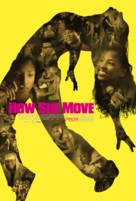Reviews provided by RottenTomatoes
Moira MacDonald, Seattle Times: There's not much that's surprising in How She Move, but watching how she moves is a pleasure. Read more
Michael Phillips, Chicago Tribune: How She Move proves you can't judge a film by its plot line, even if it sounds suspiciously similar to a few other movies about stomping the yard and dreaming your dream and dancing like you mean it. Read more
J. R. Jones, Chicago Reader: This step-dancing drama is mired in cliche, but with its dingy ghetto settings and hardened, despondent young characters, it's marginally more interesting than Stomp the Yard. Read more
Nathan Rabin, AV Club: Anyone who's seen any recent movie about troubled youngsters expressing themselves through dance-offs has essentially already seen this. Read more
Randy Cordova, Arizona Republic: How She Move, quite simply, doesn't move. Instead, the dreary, familiar tale unspools in painfully static fashion. If there's a glimmer of imagination here, it's not visible in the finished product. Read more
Ty Burr, Boston Globe: A grittier, slightly more real-world version of movies like Step Up, Stomp the Yard, and Save the Last Dance. Read more
Lisa Kennedy, Denver Post: Though it may sound like it, How She Move is not just another dance-off flick. Read more
Tom Long, Detroit News: Honestly, this is a carbon copy of every other 'gotta dance' flick ever made, down to the cheesy emcees who host the big dance-off (it's in Detroit!) and the wannabe heart-tugging conclusion. Read more
Lisa Schwarzbaum, Entertainment Weekly: She move good! Read more
Amy Nicholson, L.A. Weekly: When they dance, the effect isn't exuberant release -- every cartilage-crushing stomp-clap gets more and more furious. This is cheerleading in hell. Read more
Rafer Guzman, Newsday: Somewhere between the acrobatic dance sequences and lead-footed script of How She Move there exist fleeting glimpses of a serious film that could have been. Read more
David Denby, New Yorker: How She Move was shot on the cheap in 16-mm. film, and some of it is a little drab-looking, but it has energy and bravado. Read more
Elizabeth Weitzman, New York Daily News: How She Move gets it right in every dance sequence, but stumbles badly whenever the characters step offstage (or a car hood, or the sidewalk, or wherever they happen to be practicing). Read more
Kyle Smith, New York Post: As we replay last year's step-dance hit Stomp the Yard, the ostensible message about working hard in school gets stomped out of the yard. Read more
Roger Moore, Orlando Sentinel: Even if the setting is novel and the leads seem authentic, How She Move is all too content to step down a well-worn path. Read more
David Wiegand, San Francisco Chronicle: How She Move isn't a great film or even a terribly well-made film, but it has its moments and, of course, it has the ending it's promised all along. Read more
Colin Covert, Minneapolis Star Tribune: How She Move was nominated for the grand jury and audience award prizes at last year's Sundance Film Festival thanks to its ingratiating sincerity, a winning cast and musical numbers that could rouse the dead. Or even the Norwegian. Read more
Jason McBride, Globe and Mail: You might see the ending of How She Move coming from the first frame, but you'll tap your toes the entire way. Read more
Susan Walker, Toronto Star: In the increasingly crowded field of movies based on urban dance, How She Move stands out as a well-written and well-acted drama with an appeal that reaches beyond dance fanatics. Read more
Claudia Puig, USA Today: Though the story is predictable, How She Move has two key assets: powerful dance sequences and an emphasis on education. Read more
Jim Ridley, Village Voice: For once, the movie -- written by Annmarie Morais and directed by Ian Iqbal Rashid with a gritty overlay of 16mm grain -- regards book learning as at least as important as physical prowess. Read more
John Anderson, Washington Post: The story itself is a hodgepodge of devices, conceits and half-baked motives, but amid the dissing and the dancing are affecting moments, usually quieter ones, between people at war who shouldn't be. Read more

